We may not have the course you’re looking for. If you enquire or give us a call on +1 7204454674 and speak to our training experts, we may still be able to help with your training requirements.
Training Outcomes Within Your Budget!
We ensure quality, budget-alignment, and timely delivery by our expert instructors.

Looking to take your Java development skills from ordinary to extraordinary? Mastering Design Patterns in Java is your key to success! These patterns offer the most effective, reusable solutions for common coding challenges, providing a standardised approach to problem-solving in Software Development. This not only makes your code more understandable but also enhances communication among developers.
Design Patterns aren’t tied to any specific Programming Language or technology—they’re applicable to any object-oriented system. Whether you’re a seasoned pro or just starting out, this blog on Design Patterns in Java will boost your programming prowess and help you write cleaner, more maintainable code. Ready to dive in? Let’s go!
Table of Contents
1) What are Design Patterns in Java?
2) Why do we use Design Patterns?
3) Different Types of Design Patterns and Their Implementation
4) Miscellaneous Design Patterns
5) Conclusion
What are Design Patterns in Java?
Design patterns in Java communicate objects and classes customised to solve a general design problem within a particular context. Software design patterns are general, reusable solutions to common problems that arise during Software Development and design. They represent best practices for solving specific issues and provide a way for developers to communicate about effective design solutions.
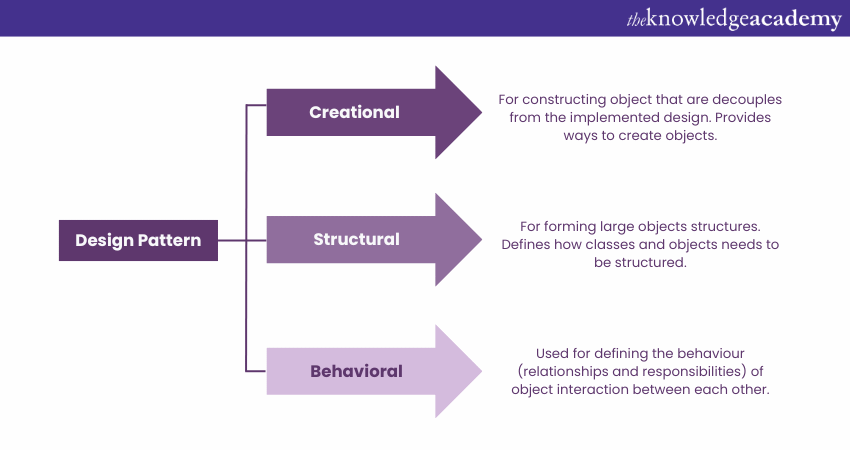
Some popular Java Design Patterns include Singleton, Factory Method, Adapter, Observer, and Strategy. These patterns have been extensively tested and proven effective in solving real-world problems. Understanding and using Design Patterns can significantly improve software Applications' quality, flexibility, and maintenance.
Why do we use Design Patterns?
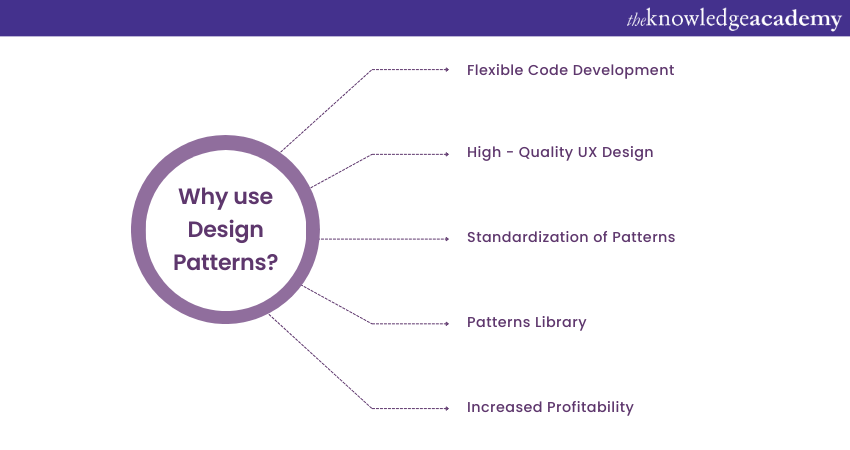
Java Design Patterns help developers create software that is modular and scalable. These patterns provide a standard way of solving problems, which makes it easier for developers to understand and communicate their code. They also help to improve the code quality and reduce the risk of introducing errors into the codebase.
Design Patterns in Java (and other Programming Languages) provide common solutions to recurring problems during software development. By following Design Patterns, developers can create more flexible and reusable code, improving software quality and reducing development time and costs.
Here are some specific reasons why Design Patterns are commonly used in Java:
1) Provides the Solution to Recurring Problems: Design Patterns provide solutions to recurring problems in software development, such as how to manage object creation, how to handle communication between objects, or how to handle errors.
2) Enhance Code Quality: Following established patterns and best practices, developers can produce higher-quality code that is easier to maintain, debug, and extend.
3) Promote Reusability: Design Patterns often focus on creating reusable code components that can be used in different parts of an application or various projects altogether. This can save time and effort in future development.
4) Improve Collaboration: Using Design Patterns, developers can communicate more effectively and understand others' code more efficiently.
Overall, Design Patterns are an essential part of modern software development and using them in Java can lead to more efficient, maintainable, high-quality code. These patterns also help users analyse the most abstract fields of a program by offering solid, tested solutions.
Master the skills required to become an expert in Java Programming language with our courses on Web Development Using Java Training.
Different Types of Design Patterns
Let's look at the different Design Patterns in Java, from creational to structural and behavioural, outlining how each type provides unique solutions to common software development challenges.

There are 23 Design Patterns in the Gang of Four (GoF) book, which is a collection of Design Patterns developed by Erich Gamma, Richard Helm, Ralph Johnson, and John Vlissides. Let’s look at the different types of Design Patterns used in Java:
1) Creational Patterns:
Creational patterns increase the flexibility of the object with the help of various object creation mechanisms. The five types of Creational patterns in Java are:
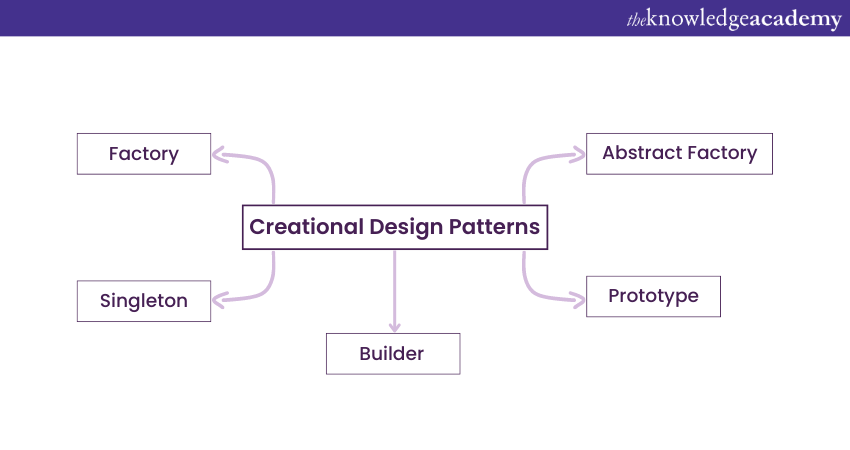
a) Singleton Pattern: This pattern helps produce only one instance of a class. It is the best solution to resolve a particular problem. A singleton pattern is applied to the log, drivers' objects, caching, and thread pool. It is also used in other Design Patterns like Abstract Factory, Builder, Prototype, Façade, etc. For example, java.lang.Runtime, java.awt.Desktop) also, use Singleton Design Pattern. Follow the example below:
|
public class Singleton { private static Singleton instance; // Private constructor to prevent instantiation from outside private Singleton() { } // Static method to get the Singleton instance public static Singleton getInstance() { if (instance == null) { instance = new Singleton(); } return instance; } // Other methods and variables of the Singleton class can be added here } |
b) Factory Method Pattern:
Suppose we have a Document superclass and several subclasses like Resume, Report, and Letter, representing different documents. Here, each subclass implements the createDocument() method to create an instance of its type. Here's an example:
|
class Document: def __init__(self): self.content = [] def add_content(self, content): self.content.append(content) def show_content(self): for item in self.content: print(item) def create_document(self): raise NotImplementedError("create_document() method is not implemented.") class Resume(Document): def create_document(self): return Resume() class Report(Document): def create_document(self): return Report() class Letter(Document): def create_document(self): return Letter() |
c) Abstract Factory Pattern: It is very similar to Factory Pattern. It is another layer of abstraction over the factory pattern. It gives a structure that allows users to create objects using a general pattern. This pattern functions with a super-factory, which helps create other factories. Follow the example below:
|
class AbstractFactory: def create_product_a(self): pass def create_product_b(self): pass # Concrete factory 1 class ConcreteFactory1(AbstractFactory): def create_product_a(self): return ProductA1() def create_product_b(self): return ProductB1() # Concrete factory 2 class ConcreteFactory2(AbstractFactory): def create_product_a(self): return ProductA2() def create_product_b(self): return ProductB2() # Abstract product A class AbstractProductA: def useful_function_a(self): pass # Concrete product A1 class ProductA1(AbstractProductA): def useful_function_a(self): return "The result of the product A1." # Concrete product A2 class ProductA2(AbstractProductA): def useful_function_a(self): return "The result of the product A2." # Abstract product B class AbstractProductB: def useful_function_b(self): pass # Concrete product B1 class ProductB1(AbstractProductB): def useful_function_b(self): return "The result of the product B1." # Concrete product B2 class ProductB2(AbstractProductB): def useful_function_b(self): return "The result of the product B2." |
Looking to step into the dynamic world of Java? Sign up for our JavaScript for Beginners Course now!
d) Builder Pattern: This Pattern aims to resolve problems related to Factory and Abstract Factory Design Patterns when the object consists of several attributes. This pattern handles the problem of many optional arguments and unpredictable state by offering a function that returns the finished object and a way to build the object step by step. Follow the example below:
|
public class Person { private String firstName; private String lastName; private int age; public Person(PersonBuilder builder) { this.firstName = builder.firstName; this.lastName = builder.lastName; this.age = builder.age; } public static class PersonBuilder { private String firstName; private String lastName; private int age; public PersonBuilder() {} public PersonBuilder firstName(String firstName) { this.firstName = firstName; return this; } public PersonBuilder lastName(String lastName) { this.lastName = lastName; return this; } public PersonBuilder age(int age) { this.age = age; return this; } public Person build() { return new Person(this); } } @Override public String toString() { return "Person{" + "firstName='" + firstName + ''' + ", lastName='" + lastName + ''' + ", age=" + age + '}'; } } |
6) Prototype Pattern: This Pattern creates new objects by copying existing ones, reducing the need for complex initialisation. Creating a new object would be expensive, time-consuming, and resource-intensive when a similar object exists. This is where the Prototype Pattern is used. Follow the example below:
|
public abstract class Shape implements Cloneable { private String type; public String getType() { return type; } public void setType(String type) { this.type = type; } public abstract void draw(); public Object clone() { Object clone = null; try { clone = super.clone(); } catch (CloneNotSupportedException e) { e.printStackTrace(); } return clone; } } public class Circle extends Shape { public Circle() { setType("Circle"); } @Override public void draw() { System.out.println("Drawing a circle."); } } public class Rectangle extends Shape { public Rectangle() { setType("Rectangle"); } @Override public void draw() { System.out.println("Drawing a rectangle."); } } public class PrototypePatternExample { public static void main(String[] args) { Circle circle = new Circle(); Circle clonedCircle = (Circle) circle.clone(); Rectangle rectangle = new Rectangle(); Rectangle clonedRectangle = (Rectangle) rectangle.clone(); System.out.println("Original Circle Type: " + circle.getType()); System.out.println("Cloned Circle Type: " + clonedCircle.getType()); System.out.println("Original Rectangle Type: " + rectangle.getType()); System.out.println("Cloned Rectangle Type: " + clonedRectangle.getType()); } } |
Explore the primary concepts of advance Java with our Introduction To Java EE Course – Sign up now!
2) Structural Patterns:
Structural Patterns deal with object composition and provide ways to form larger structures of objects from smaller ones. The seven types of Structural Patterns in Java are:
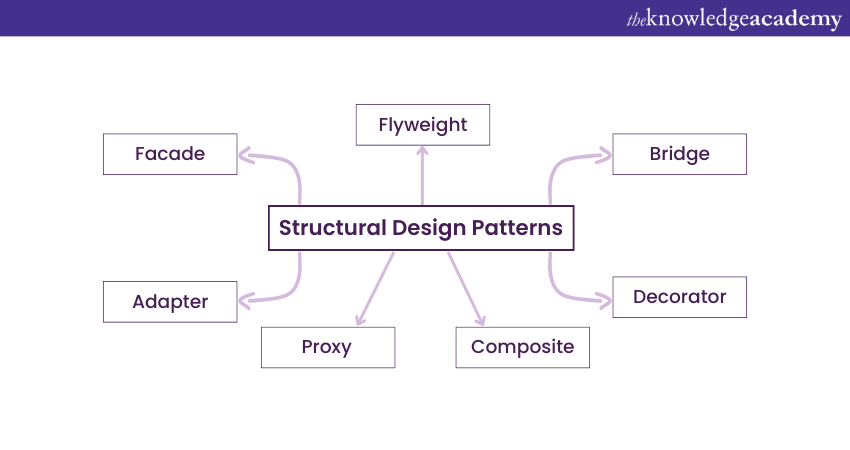
a) Adapter Pattern: One of the Structural Design Patterns used to connect two unconnected interfaces is the Adapter Design Pattern. An adapter is an entity that connects these disparate interfaces. This Pattern enables the coexistence of two incompatible interfaces by encircling one of the interfaces with an object to make the other interface compatible. Follow the example below:
|
public interface MediaPlayer { public void play(String audioType, String fileName); } public interface AdvancedMediaPlayer { public void playVlc(String fileName); public void playMp4(String fileName); } public class VlcPlayer implements AdvancedMediaPlayer{ @Override public void playVlc(String fileName) { System.out.println("Playing vlc file. Name: "+ fileName); } @Override public void playMp4(String fileName) { // Do nothing } } public class Mp4Player implements AdvancedMediaPlayer{ @Override public void playVlc(String fileName) { // Do nothing } @Override public void playMp4(String fileName) { System.out.println("Playing mp4 file. Name: "+ fileName); } } public class MediaAdapter implements MediaPlayer { AdvancedMediaPlayer advancedMusicPlayer; public MediaAdapter(String audioType){ if(audioType.equalsIgnoreCase("vlc") ){ advancedMusicPlayer = new VlcPlayer(); } else if (audioType.equalsIgnoreCase("mp4")){ advancedMusicPlayer = new Mp4Player(); } } @Override public void play(String audioType, String fileName) { if(audioType.equalsIgnoreCase("vlc")){ advancedMusicPlayer.playVlc(fileName); } else if(audioType.equalsIgnoreCase("mp4")){ advancedMusicPlayer.playMp4(fileName); } } } public class AudioPlayer implements MediaPlayer { MediaAdapter mediaAdapter; @Override public void play(String audioType, String fileName) { // Inbuilt support to play mp3 music files if(audioType.equalsIgnoreCase("mp3")){ System.out.println("Playing mp3 file. Name: " + fileName); } // mediaAdapter is providing support to play other file formats else if(audioType.equalsIgnoreCase("vlc") || audioType.equalsIgnoreCase("mp4")){ mediaAdapter = new MediaAdapter(audioType); mediaAdapter.play(audioType, fileName); } else{ System.out.println("Invalid media. " + audioType + " format not supported"); } } } |
Looking to hone your skills in Java programming for developing applications and embedded systems Sign up for our Java Engineer Training now!
b) Bridge Pattern: The Bridge Design Pattern is used to decouple the interfaces from the implementation. It is also applied to conceal the implementation details from the client applications when we have interface hierarchies in both the interfaces and the implementations. The Bridge Design Pattern adheres to the principle of favouring composition over inheritance. Follow the example below:
|
public interface Shape { void draw(); } public class Circle implements Shape { private final Color color; public Circle(Color color) { this.color = color; } @Override public void draw() { System.out.println("Drawing a " + color.getColor() + " circle."); } } public interface Color { String getColor(); } public class RedColor implements Color { @Override public String getColor() { return "red"; } } public class BlueColor implements Color { @Override public String getColor() { return "blue"; } } public class Main { public static void main(String[] args) { Shape redCircle = new Circle(new RedColor()); Shape blueCircle = new Circle(new BlueColor()); redCircle.draw(); blueCircle.draw(); } } |
c) Composite Pattern: This Pattern enables clients to handle both individual objects and object compositions consistently. When we need to build a structure so that all the things inside it can be handled equally, we use the Composite Pattern. Follow the example below:
|
public interface Component { void operation(); } public class Leaf implements Component { public void operation() { System.out.println("Leaf operation"); } } public class Composite implements Component { private List public void add(Component component) { children.add(component); } public void remove(Component component) { children.remove(component); } public void operation() { System.out.println("Composite operation"); for (Component child : children) { child.operation(); } } } |
d) Decorator Pattern: By encasing an object in one or more decorators, this pattern dynamically adds obligations to the object. This pattern is applied to change an object's functionality during its runtime. Follow the example below:
// The interface for the component we want to decorate
|
// The interface for the component we want to decorate interface Pizza { String getDescription(); double getCost(); } // The concrete implementation of the Pizza interface class PlainPizza implements Pizza { @Override public String getDescription() { return "Plain pizza"; } @Override public double getCost() { return 5.0; } } // The decorator abstract class that implements the Pizza interface and holds a reference to a Pizza object abstract class PizzaDecorator implements Pizza { protected Pizza pizza; public PizzaDecorator(Pizza pizza) { this.pizza = pizza; } @Override public String getDescription() { return pizza.getDescription(); } @Override public double getCost() { return pizza.getCost(); } } // The concrete decorator that adds toppings to the pizza class ToppingDecorator extends PizzaDecorator { public ToppingDecorator(Pizza pizza) { super(pizza); } @Override public String getDescription() { return pizza.getDescription() + ", with toppings"; } @Override public double getCost() { return pizza.getCost() + 2.0; } } // Client code that uses the decorator pattern to create and decorate pizzas public class PizzaClient { public static void main(String[] args) { Pizza plainPizza = new PlainPizza(); Pizza pizzaWithToppings = new ToppingDecorator(plainPizza); System.out.println(plainPizza.getDescription() + " costs $" + plainPizza.getCost()); System.out.println(pizzaWithToppings.getDescription() + " costs $" + pizzaWithToppings.getCost()); } } |
e) Facade Pattern: It provides a unified interface to a set of interfaces in a subsystem, simplifying its usage. One structural design pattern is the facade Design Pattern (such as the adapter and decorator patterns). Client applications are made to interact with the system more easily using the Facade Design Pattern. Follow the example below:
|
public class Facade { public void operation() { System.out.println("Facade is performing operation."); } } public class Main { public static void main(String[] args) { Facade facade = new Facade(); facade.operation(); // Facade is performing operation. } } |
f) Flyweight Pattern: When you need to construct many objects belonging to a class, the Flyweight Design Pattern is used. The low-memory devices (such as mobile devices or embedded systems), when every Object uses memory, the Flyweight Design Pattern can be used to share objects and lessen the burden on memory. Here's a simple example of how to implement the Flyweight pattern in Java:
|
import java.util.HashMap; import java.util.Map; public class FlyweightFactory { private Map public Flyweight getFlyweight(String key) { if (flyweights.containsKey(key)) { return flyweights.get(key); } else { Flyweight flyweight = new ConcreteFlyweight(key); flyweights.put(key, flyweight); return flyweight; } } } public interface Flyweight { void operation(); } public class ConcreteFlyweight implements Flyweight { private String key; public ConcreteFlyweight(String key) { this.key = key; } public void operation() { System.out.println("ConcreteFlyweight with key " + key + " is doing operation."); } } public class Client { public static void main(String[] args) { FlyweightFactory factory = new FlyweightFactory();
Flyweight flyweight1 = factory.getFlyweight("key1"); Flyweight flyweight2 = factory.getFlyweight("key1"); flyweight1.operation(); flyweight2.operation(); System.out.println(flyweight1 == flyweight2); } } |
g) Proxy Pattern: This Design Pattern offers a stand-in or substitutes for another item to manage access to it.
Let's say we have an interface Internet that defines a method connectTo(String serverHost):
|
public interface Internet { void connectTo(String serverHost); } |
We also have a concrete implementation of the Internet interface, called RealInternet:
|
public class RealInternet implements Internet { @Override public void connectTo(String serverHost) { System.out.println("Connecting to " + serverHost); } } |
This implementation connects to the specified server host.
Now, let's say we want to restrict access to certain server hosts based on some criteria. We can use the Proxy pattern to achieve this. Here's the ProxyInternet class that implements the Internet interface as well:
|
public class ProxyInternet implements Internet { private Internet internet = new RealInternet(); private List
|
The ProxyInternet class contains a reference to a RealInternet object and maintains a list of banned server hosts. If a server host is in the banned list, the connectTo() method of the ProxyInternet class denies access to it. Otherwise, it forwards the request to the connectTo() method of the RealInternet object.
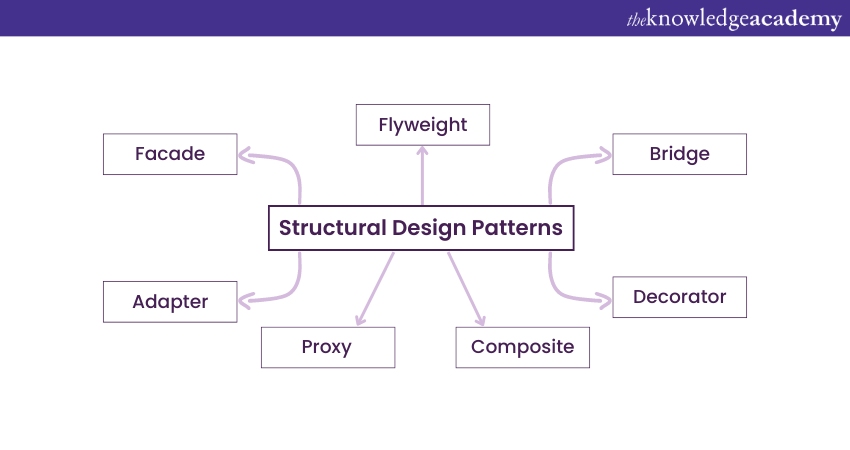
3) Behavioural Patte
Frequently Asked Questions

Design patterns are valuable for recurring design problems, providing tested solutions for common software challenges. They promote code flexibility and reusability, and improve team communication with a common vocabulary. By applying principles like encapsulation and separation of concerns, they improve modularity as well.

Avoid using Design Patterns for small problems, as they add complexity and overhead. Don’t optimise with patterns before identifying performance issues, as this can complicate the code. Also, misuse of unfamiliar patterns can cause design flaws and hinder adaptability in more dynamic environments.

The Knowledge Academy takes global learning to new heights, offering over 30,000 online courses across 490+ locations in 220 countries. This expansive reach ensures accessibility and convenience for learners worldwide.
Alongside our diverse Online Course Catalogue, encompassing 17 major categories, we go the extra mile by providing a plethora of free educational Online Resources like News updates, Blogs, videos, webinars, and interview questions. Tailoring learning experiences further, professionals can maximise value with customisable Course Bundles of TKA.

The Knowledge Academy’s Knowledge Pass, a prepaid voucher, adds another layer of flexibility, allowing course bookings over a 12-month period. Join us on a journey where education knows no bounds.

The Knowledge Academy offers various Java Courses, including the JavaScript for Beginners Course and the Java Swing Development Course. These courses cater to different skill levels, providing comprehensive insights into Career in Java.
Our Programming & DevOps Blogs cover a range of topics related to Java, offering valuable resources, best practices, and industry insights. Whether you are a beginner or looking to advance your Java Development skills, The Knowledge Academy's diverse courses and informative blogs have got you covered.
Upcoming Programming & DevOps Resources Batches & Dates
Date
 Java Programming
Java Programming
Mon 13th Jan 2025
Mon 10th Mar 2025
Mon 19th May 2025
Mon 21st Jul 2025
Mon 15th Sep 2025
Mon 17th Nov 2025
Mon 15th Dec 2025







 Top Rated Course
Top Rated Course



 If you wish to make any changes to your course, please
If you wish to make any changes to your course, please


